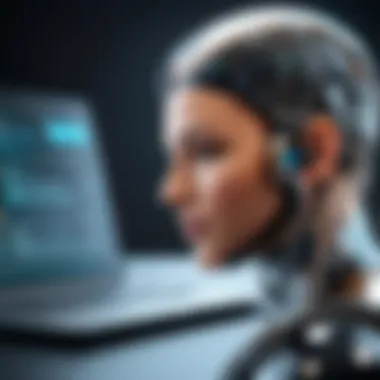Enhancing Document Accessibility with OCR Technology


Intro
In today’s digital world, document accessibility is crucial. Organizations must efficiently manage vast amounts of information. Optical Character Recognition (OCR) technology plays a significant role in making documents searchable and accessible. This article explores the importance of OCR, its applications, and the challenges involved in optimizing document accessibility.
The integration of OCR technology into document management systems enhances user experience and improves workflow. It transforms scanned images into editable text. This transformation is fundamental for businesses striving to make their documents more accessible. By digitizing paperwork, companies can streamline operations and ensure compliance with legal standards regarding accessibility.
As we delve deeper into the specifics of OCR, we will first assess the software needs that arise in implementing this technology effectively.
Prologue to OCR Technology
The topic of Optical Character Recognition (OCR) technology is at the core of optimizing document accessibility. Given the digital transformation in many sectors, it is critical to understand OCR's role in making information easier to access and manage. The importance of this technology lies in its ability to convert different types of documents, such as scanned paper documents, PDFs, or images captured by a digital camera, into editable and searchable data. This ability significantly enhances document management practices, facilitating seamless data retrieval and improved workflow efficiency.
Definition and Basic Principles
Optical Character Recognition refers to the technological process of converting images of typed, handwritten, or printed text into machine-encoded text. OCR is typically employed to digitize printed documents, making the contents editable and searchable. The basic working principle of OCR involves image preprocessing, where the text image may undergo various transformations to enhance quality. This is followed by pattern recognition, where the software identifies characters based on shapes and predefined rules. The entire process is crucial for improving data accessibility, especially when large volumes of documents are involved.
Brief History of OCR Development
The development of OCR technology has evolved significantly since its inception in the early 20th century. The first successful OCR machine, known as the "Reading Machine,” was invented by Emanuel Goldberg in the 1920s. However, it wasn't until the 1960s that true advancements were made, with the introduction of computer-based OCR systems. By the 1980s, commercial OCR software like Kurzweil 1000 entered the market, paving the way for wide adoption in various industries. Today, integrated systems utilize sophisticated algorithms and deep learning for enhanced recognition accuracy, rendering OCR an indispensable tool for managing documents effectively and efficiently.
OCR technology plays a crucial role in streamlining workflows by enabling users to quickly access and utilize information from a multitude of document types.
Understanding OCR technology is vital for anyone invested in streamlining workflows and boosting productivity in document management. With increasing volumes of information being digitized, the relevance of extracting meaningful data from various formats will only continue to grow.
Understanding How OCR Works
Understanding how Optical Character Recognition (OCR) works is crucial for grasping its role in optimizing document accessibility. OCR technology transforms various document formats into editable and searchable digital text. This process enhances accessibility for individuals and businesses by making information readily available. It ensures that users can easily locate and retrieve data, even from previously unedited sources.
Image Acquisition Process
The image acquisition process is the very first step in OCR. It involves capturing the physical document, which can be achieved through scanners or cameras. The quality of the images significantly impacts the OCR’s performance.
Documents can vary greatly in quality. Clear, high-resolution images yield better results compared to those from low-quality sources.
Here are some key points regarding the image acquisition process:
- Scanner Type: Different types of scanners exist, such as flatbed and handheld scanners. Choosing the right one is important for specific needs.
- Resolution: A higher resolution helps improve character recognition accuracy, typically at least 300 DPI (dot per inch) is recommended.
- Orientation: Properly orienting the document can minimize errors during subsequent OCR processes.
Preprocessing Techniques
Preprocessing techniques play an essential role in preparing captured images for optimal OCR performance. These methods help clean up the data, making it easier for the software to recognize characters accurately.
Common preprocessing techniques include:
- Noise Reduction: Removing background noise or distortion enhances the clarity of the text.
- Binarization: Converting the image to black and white can help isolate text from backgrounds, improving recognition.
- Skew Correction: Aligning images correctly reduces errors from misaligned text. OCR systems may struggle with slanted documents.
Effective preprocessing ultimately increases the accuracy of character recognition, leading to better results in document accessibility.
Character Recognition Process
The character recognition process is where OCR technology truly shines. After preprocessing, this step converts images of text into machine-encoded text.
There are two primary methods of character recognition:


- Pattern Recognition: This technique involves comparing the detected characters to a database of known patterns. It is common for typewritten text.
- Feature Extraction: This method analyzes specific features of characters, such as lines and curves, allowing for more robust recognition, particularly with handwritten text.
The results of the character recognition process can vary based on several factors:
- Quality of Input: Higher quality scans lead to better outcomes.
- Language and Font Variability: Different languages and fonts can complicate recognition. OCR systems perform better with well-known fonts.
- Machine Learning: More advanced OCR systems leverage machine learning algorithms to improve accuracy over time by learning from errors.
"The accuracy of OCR systems can significantly influence the effectiveness of automated document management solutions."
In summary, understanding how OCR works encompasses the entire journey from image capture to text recognition. Each step of this process is vital for ensuring that documents are accessible. Proper execution of these components maximizes the advantages of OCR technology in improving document accessibility.
Key Applications of OCR Technology
Understanding the key applications of Optical Character Recognition (OCR) technology is fundamental in grasping its role in enhancing document accessibility. OCR can revolutionize how organizations manage and retrieve information. It bridges the gap between analog and digital data, allowing businesses to handle massive volumes of documents efficiently. With its various implementations, OCR technology not only facilitates faster data access but also cultivates a more organized workflow, ultimately increasing productivity.
Document Digitization in Enterprises
Document digitization is perhaps one of the most significant applications of OCR in enterprises today. Traditional paper-based systems often lead to inefficiencies, such as lost documents and slow retrieval times. By converting printed documents into editable and searchable digital formats, OCR streamlines documentation processes. This implementation helps organizations maintain regulatory compliance by ensuring that important records are easily accessible and securely stored.
Benefits of Document Digitization:
- Efficiency: Moving to a digital format allows for faster searches and reduced time in manual processing.
- Space Saving: Reducing physical storage needs frees up space and minimizes overhead costs.
- Cost-Effectiveness: Digitization significantly cuts costs associated with printing, filing, and managing physical documents.
Processing Financial Documents
Financial documents often require accurate data extraction and processing. OCR technology enhances this by automating the input of information from invoices, bills, and financial statements. The ability to convert these documents into structured data reduces human error and increases processing speed. Furthermore, the integration of OCR with financial software can facilitate real-time data analysis, which is crucial for decision-making in any financial institution.
Key Considerations for Financial Document Processing:
- Accuracy: Advanced OCR systems have improved accuracy for printed texts, but intensive review is still needed for any extracted data.
- Security: Sensitive information requires robust security measures to ensure compliance with financial regulations.
- Scalability: The ability to handle varying volumes of documents is essential, especially during peak financial seasons.
Enhancing Legal Document Management
The legal field has a unique set of demands concerning document management. With a myriad of regulations and requirements, law firms can benefit greatly from OCR technology. This technology helps in digitizing legal contracts, case briefs, and memos, thus enhancing ease of access and management.
By utilizing OCR, documents can be indexed and made searchable. This capability proves critical when it comes to finding relevant case laws or previous agreements swiftly.
Advantages of OCR in Legal Management:
- Improved Searchability: Quickly locate documents based on keywords or phrases.
- Version Control: Handle multiple versions of contracts and documents, ensuring that all revisions are tracked.
- Collaboration: Enable teams to work on documents seamlessly, no matter their location.
"OCR technology not only saves time but also helps legal professionals focus more on case strategy rather than administrative tasks."
Understanding these applications of OCR technology informs its strategic implementation in various sectors. The flexibility and efficiency brought by OCR are making it an invaluable tool for businesses and organizations aiming to enhance their document accessibility.
Integrating OCR can lead to transformative improvements, paving the way for digital transformation in workplaces.
Advantages of Implementing OCR Solutions
The integration of Optical Character Recognition (OCR) technology provides substantial benefits across various sectors. Understanding its advantages can help organizations make informed decisions about document management strategies. The use of OCR enhances efficiency, reduces costs, and improves data accessibility. These elements are crucial for streamlining workflows in today’s fast-paced environment.
Increased Efficiency in Document Handling
Efficient document handling is an essential aspect of any organization. OCR technology automates the conversion of paper documents into editable and searchable digital formats. This automatic processing leads to significant time savings. Employees can focus on higher-value tasks rather than spending hours on manual data entry.


Moreover, OCR enables batch processing of documents. Users can scan multiple pages at once, and the software can process them in a single operation. This efficiency drastically reduces the time spent on document management activities. With OCR, search functions become much faster too. Staff can locate information quickly without having to sift through various files manually.
Cost Reduction and Resource Optimization
Incorporating OCR technology can lead to substantial cost savings for organizations. The elimination of paper storage reduces physical space expenses and decreases the need for printing supplies. Furthermore, automation results in fewer human errors, which can lead to financial liabilities and rework costs.
Resource optimization is another critical benefit. By digitizing documents, companies can minimize overhead costs associated with paper documents. Employees can use their time on essential projects rather than routine tasks. For example, instead of searching for information in physical files, they can access it instantly from a digital system, leading to improved overall productivity.
Improved Data Accessibility and Retrieval
One of the primary advantages of OCR is enhanced data accessibility. Once documents are digitized, they become easier to organize, store, and retrieve. Retrieval times are greatly reduced, as users can leverage search functions to find specific data without needing to browse through every document manually.
Moreover, OCR raises the level of accessibility for different stakeholders. Information stored in readable formats aids compliance with regulations regarding data accessibility for individuals with disabilities. This is another critical consideration in today’s inclusive environment. With the ability to convert content into various formats, organizations can ensure information reaches a broader audience.
"Implementing OCR technology is a strategic move that not only enhances efficiency but also fosters inclusivity in information access."
Challenges in OCR Technology Deployment
The deployment of OCR technology in organizations can significantly enhance document accessibility. However, it is not without its challenges. Understanding these hurdles is crucial for successful implementation. Each challenge has various implications on performance and effectiveness, making it important to address them properly.
Accuracy and Error Rates
One of the primary concerns with OCR technology is its accuracy. Despite the advancements made in OCR software, achieving high levels of accuracy remains a daunting task. Factors influencing accuracy include the quality of the source document, the font types used, and the complexity of layouts.
Many OCR systems struggle particularly with documents that have poor image quality or non-standard fonts. Statistical errors, such as misrecognized characters, can lead to significant problems, particularly in industries where precision is paramount, like legal or financial sectors. The consequences of data inaccuracies might mean time-consuming corrections, costly errors, or end-user frustrations. Organizations must adopt rigorous accuracy assessment processes and possibly consider multiple OCR solutions to find the best fit for their needs.
Difficulties with Handwritten Text Recognition
Handwritten text poses another significant challenge for OCR technology. Unlike printed text, handwriting varies widely between individuals. This variability complicates character recognition algorithms, often resulting in lower recognition rates compared to printed content.
Moreover, certain handwritten styles have inherent inconsistencies, leading to higher error rates in recognition. In sectors where handwritten notes are prevalent, such as healthcare with patient records, the inability to accurately convert handwriting to digital text restricts the utility of OCR. Companies may need to explore specialized solutions that incorporate machine learning to improve handwritten text recognition capabilities. This field is still developing and might not always meet user expectations.
Integration with Existing Systems
Integrating OCR technology with existing systems is another significant challenge. Organizations may already have established workflows and software solutions that do not naturally accommodate OCR functionalities. Disparate systems frequently present compatibility issues, leading to delays and inefficiencies.
To bridge this gap, it may require substantial time and resources. Effective integration needs an assessment of current infrastructure and identifying areas where OCR implementation will bring benefits. This often includes modifying workflows, training employees, or migrating data to accommodate new OCR capabilities.
Overall, overcoming these challenges is key for organizations to fully realize the potential benefits of OCR technology. Addressing them thoughtfully will not only enhance document accessibility but also improve overall operational efficiency.
The Role of Artificial Intelligence in OCR
Artificial intelligence (AI) plays a critical role in the evolution and effectiveness of Optical Character Recognition (OCR) technology. The intersection of these two fields not only enhances the accuracy of text recognition but also expands the applications of OCR in various industries. By incorporating AI strategies, such as machine learning and natural language processing, OCR systems can achieve more reliable outputs, especially when dealing with complex documents and diverse languages. This section will delve into the specific contributions of AI, highlighting its benefits and considerations.
Machine Learning Techniques in OCR
Machine learning techniques have revolutionized the capabilities of OCR systems. Traditional OCR methods relied heavily on rule-based algorithms, which often struggled with variations in font styles, sizes, and layouts. Machine learning, however, allows OCR systems to learn from vast amounts of data. As the system processes more images, it adapts and improves its accuracy. This involves training the model using labeled datasets, where the correct outputs are provided. The model learns to recognize patterns and characteristics of characters in different contexts.
Some popular machine learning approaches in OCR include:
- Convolutional Neural Networks (CNNs): These networks are particularly effective in image processing tasks and help improve character recognition.
- Recurrent Neural Networks (RNNs): Enhances the OCR capability to understand and generate text by considering sequences of characters in context.
This evolving intelligence enables OCR software to handle more complex text recognition tasks, such as recognizing custom fonts or even handwritten text in some cases.


Natural Language Processing Contributions
Natural language processing (NLP) further enhances the efficiency of OCR technology. While OCR focuses on converting images of text into machine-readable text, NLP aids in interpreting the textual data extracted. This becomes critical when ensuring the accuracy of the recognized text or when the text includes language idioms or contextual meanings.
NLP contributes to OCR in several ways:
- Contextual Understanding: By analyzing the context in which words are used, NLP can help correct misidentified characters. For example, distinguishing between "1" and "l" based on surrounding words.
- Entity Recognition: NLP helps identify and categorize words into entities like names, places, and dates, improving the organization of extracted data.
- Language Detection: Modern OCR systems use NLP to identify the language of the text, allowing them to apply specific language rules and improve recognition accuracy.
"The integration of AI into OCR technology marks a transformative step in optimizing document accessibility, allowing for better handling of diverse formats and improving overall efficiency."
Future Trends in OCR Technology
The landscape of Optical Character Recognition technology is ever-evolving. Understanding future trends is essential for organizations that want to stay ahead of the curve. These trends not only promise improvements in efficiency and accuracy but also address the growing need for enhanced document accessibility. This section offers insight into significant advancements that can shape the OCR world in the upcoming years.
Advancements in Optical Character Recognition
Recent developments in OCR have opened new frontiers. One notable advancement involves the integration of deep learning and neural networks into the OCR process. This enhances accuracy, particularly in recognizing complex fonts and layouts. The use of convolutional neural networks has facilitated improved recognition even in cases of low-quality images.
Additionally, new algorithms are being developed that allow for real-time processing of documents. This can dramatically speed up workflows in various industries. Companies like ABBYY and Google are at the forefront, leveraging these advanced techniques to offer solutions that exceed traditional OCR capabilities.
Also, multilingual recognition is becoming increasingly refined. OCR systems can now handle documents containing multiple languages more effectively, which is invaluable for global organizations. This functionality ensures that language barriers do not impede document accessibility.
Integration with Cloud Computing
Cloud computing is reshaping how OCR technology is deployed. With the ability to process large volumes of data in real-time, cloud-based solutions offer scalability and accessibility that local installations cannot compete with. This model enhances collaboration among users by allowing remote access to documents.
Furthermore, cloud integration facilitates the storage of large datasets often necessary for training machine learning models used for OCR. Organizations can access these powerful tools without heavy investments in infrastructure. For instance, services offered by Microsoft Azure and Amazon Web Services streamline the deployment of OCR processes, ensuring businesses leverage the technology efficiently.
Emerging cloud capabilities also lead to reduced costs. By utilizing shared resources, companies can minimize the expenses often associated with maintaining hardware and software. Increased efficiency and cost savings make cloud OCR a compelling option.
Emerging Markets and Use Cases
OCR technology is finding traction in new markets and diverse applications. Sectors like healthcare and education are increasingly adopting OCR solutions to enhance accessibility and operational efficiency. In healthcare, for example, OCR is used to digitize medical records, which streamlines patient management. This can result in faster access to patient information and improved healthcare delivery.
In education, OCR facilitates the conversion of printed materials into editable and searchable formats. This is crucial for institutions aiming to support students with disabilities, ensuring compliance with accessibility standards.
Moreover, the rise of e-commerce has led to innovative uses of OCR in inventory management and order processing. Retailers are leveraging this technology for automated data input and improved stock management. This not only enhances accuracy but also decreases the time needed for these tasks, which can contribute to better customer service.
“The future of OCR technology is not just about improving accuracy; it’s about making information accessible for everyone.”
Understanding these trends allows organizations to harness OCR technology effectively. By recognizing the shifts in technology and market needs, entities can better equip themselves to optimize document accessibility.
End
In this article, we have explored the critical role of OCR technology in enhancing document accessibility. The topic is of utmost importance for numerous reasons, especially given the increasing reliance on digitized documents in various sectors. Optimizing document accessibility through OCR not only facilitates efficient data management but also democratizes access to information for individuals with varying needs.
Summary of Key Insights
The journey through OCR technology has clarified several key insights:
- Efficiency Gains: The automation of data entry processes significantly reduces labor costs and time. Businesses can convert vast quantities of paper documents into searchable digital formats quickly.
- Enhanced Accessibility: Organizations can provide greater access to information for people with disabilities, thus promoting inclusivity. OCR technology plays a role in making printed texts readable by screen readers, further supporting users who rely on assistive technologies.
- Integration Challenges: The deployment of OCR can present challenges, such as accuracy in character recognition and integration with existing systems. Understanding these obstacles is crucial for successful implementation.
- Future Prospects: With advancements in AI and cloud computing, the future of OCR technology seems promising. Enhanced machine learning algorithms are continually refining how OCR interprets text, leading to higher accuracy rates.
Recommendations for Implementing OCR
To ensure a successful implementation of OCR solutions, consider these recommendations:
- Assess Specific Needs: Before selecting an OCR software, evaluate the specific requirements of the organization. Different applications may necessitate different features in OCR technology.
- Choose the Right Software: Invest in reputable OCR software solutions, such as Adobe Acrobat, ABBYY FineReader, or Tesseract. Each has unique strengths suited for various document types.
- Training and Testing: Ensure proper training for staff on how to use OCR tools effectively. Conduct thorough testing on various document types to identify potential challenges in character recognition.
- Integrate Strategically: Make a comprehensive integration plan to align OCR systems with existing document management frameworks. This is essential for maximizing efficiency.
- Monitor and Improve: Regularly monitor the performance of the OCR system. Gathering feedback from users can provide insights into areas needing improvement, enabling adjustments that enhance usability.
"Investing in OCR technology is more than just acquiring a tool; it is about revolutionizing how organizations manage information for the better."







